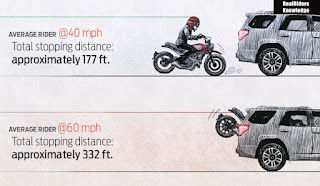You’re riding along minding your own business when suddenly you’re facing the bumper of a left-turning SUV. Every cell commands you to get the motorcycle stopped ASAP to prevent your early demise. But will your response be quick enough?
It’s a good thing we’re hardwired to respond immediately to threats, but too often our synapses don’t fire fast enough for a quick and effective response. Thankfully, there are ways to help make sure you aren’t a victim of “too little too late.”
There are actually two components of reaction time: “perception time” and “activation time.” Perception time is the time it takes to figure out what’s going on and decide what action to take. Activation time is the time it takes to reach for the brakes. You also have to account for the amount of time it takes to actually get the bike stopped.
Let’s say you’re traveling at 40 mph, which is about 56 feet per second. A reasonably attentive rider will typically use about one second of “thinking” time to perceive the situation and begin applying the brakes. Add at least 0.5 second or more if you’re daydreaming. That equates to between 56 and 84 feet before any physical action is taken.
The actual time it takes to stop the motorcycle depends on your bike’s weight, travel speed, and available traction, as well as the efficiency of your brain-to-muscle communication and your ability to use all of your brakes’ potential without skidding (ABS helps in this regard). From 40 mph a typical rider will need somewhere between 100 and 125 feet to get the bike stopped, depending on ability. Add perception, activation, and braking distances together and you could need up to 200 feet to stop.
With perception time adding nearly 50 percent to the total stopping distance, you can see why it’s so important to remain alert. You also want to develop your ability to predict when bad things are about to happen before they unfold. Get ahead of sketchy situations by aggressively scanning for clues that indicate trouble. Be especially vigilant when approaching intersections, where most collisions occur.
You can reduce activation time by covering the front brake lever and rear brake pedal when approaching potential hot spots. Not only will this simple action reduce activation time, but it also puts your whole system on alert. Of course, the best way to reduce braking distances is to slow down. Trimming just 5 mph off your 40-mph travel speed requires about 20 fewer feet to stop. Add 5 mph and you’ll need about 25 more feet to stop. Speed up to 60 mph and you’re going to need nearly twice the stopping distance as you would from 40 mph.
Hard braking when the bike is upright is tricky enough when facing an emergency. But things get even more challenging when you have to stop quickly while leaned because of a hazard around a corner. Perception, activation, and braking time still apply, but now you also need to add time to reduce lean angle. You reduce lean angle to free up traction that’s being used for cornering so you can brake hard with less chance of traction loss. This necessary action adds to total stopping distance. Machines with cornering ABS offer a distinct advantage here where you can brake hard while maintaining lean angle.
Whether or not you avoid a crash is dependent on your ability to react quickly when an otherwise sublime day suddenly turns into a DEFCON 1 war zone. The best riders remain alert and ready for battle and waste very little processing time before executing evasive action. They also cover the brakes to reduce activation time when approaching intersections. The final step is to regularly practice emergency braking techniques. Can you stop your motorcycle in the shortest possible distance while maintaining control? Too many riders can’t…Labels: Knowledge, Tips
